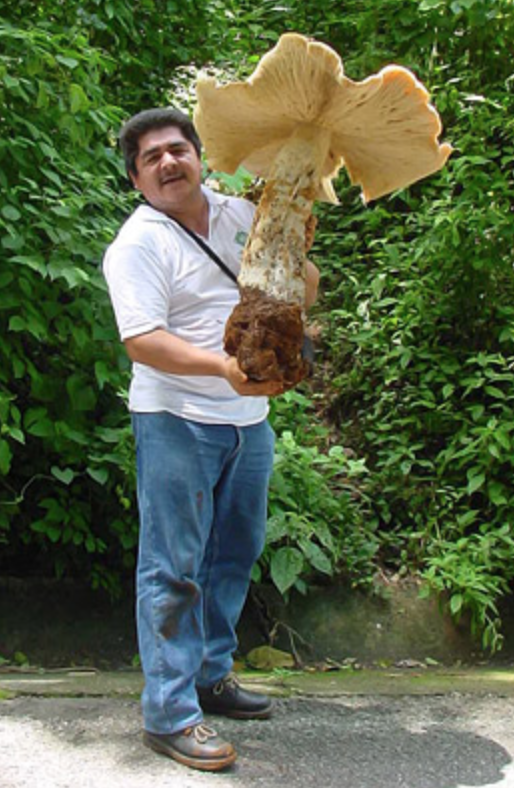Macrocybe titans, also known as the American titan, is easily the largest fruiting body of the Americas. In a previous Fungi Friday, I wrote about a termite loving African mushroom called Termitomyces titanicus. Like its species name suggests, it too grows incredibly robust. Although they both put out some of the largest mushrooms on the planet, they differ in their ecology. The way each species makes a living differs quite dramatically, so I will remind the reader why directional selection towards larger fruiting bodies has occurred in at least one of these species. Here, I posit a few hypotheses regarding this magnificent American titan. It has too many similarities with the massive Termitomyces titanicus fruiting on the other side of the planet, and although little research has been done on this species ecology, with our mycological understanding, we can begin to put the pieces together.
Macrocybe titans, the American titan. Photo by J. Teodoro Chivata Bedoya.
Macrocybe titans is truly a titan, with some specimens growing an incredible meter across!! If you are completely oblivious and do not see one of these huge mushrooms while you’re walking, you will trip and fall. Not many mushrooms can withstand the stepping of a grown man/women, with 99.99% of mushrooms being easily kicked over. This is speculative, and I have never tripped on this mushroom (no pun intended) but your unaware average human is no match for this monstrosity.
Unlike the African Termitomyces titanicus that strictly grows within termite mounds until it fruits, Macrocybe titans grows from the ground in warm woodland and grassland ecosystems. Instead of being fed a continuous flow of woody debris from insect mutualists, Macrocybe titans is said to live a solitary, saprophytic lifestyle, breaking down dead organic material into digestible sugars. Yet this is somewhat convoluted since it has also been scientifically documented growing from leafcutter ant mounds! For some reason, no entomologist or mycologist has looked into this interaction so again, I’m being speculative, but the similarities between both colossal species are actually quite striking.
The equally impressive Termitomyces titanicus found throughout termite inhabiting savanna ecosystems in Africa.
My hypothesis is that both species evolved a mutualism with colony forming insects. Termitomyces titanicus is a specialist that only can function with its termite counterpart while Macrocybe titans has a more generalist ecology, and can carry out an interaction with leafcutter ants as well as live a solitary saprophytic lifestyle. Again, I’m left shook that researchers have not looked more closely at this interaction. These are the two largest mushrooms on the planet. Although possible, there’s no way Macrocybe titans grows from leafcutter ant mounds by chance. I think this is the species ancestral trait. Let me explain.
In my Termitomyces titanicus article, I explain that a directional selection towards larger individuals promoted the species fitness. One reason larger mushrooms evolved in this species was because of their dependable, steady flow of an excellent food source (masticated woody debris) from their termite counterpart. The other reason is because of the patchy distribution of termite mounds in their unproductive African savanna ecosystems. Unlike leafcutter ants that bring their fungal cultivar to a new nest site, when reproductive termites leave their original mounds to set up new colonies, they do not bring their fungal counterpart. Over millions of years, termite specialized fungi that produced larger mushrooms, also produced more spores. The more spores produced, the better chances of colonizing a new termite mound. Now this is where it gets really interesting.
Macrocybe titans
Copyright © 2007 El Colegio de la Frontera Sur (Ecosur)
I just mentioned that reproductive leafcutter individuals bring a piece of the fungal garden with them when they disperse to a new site to set up a new colony. So why would there be this same directional selection towards larger mushrooms? Many mutualistic fungi that have co-evolved with leafcutter ants for millions of years have gone the opposite route, and have completely lost the ability to form sexual structures (mushrooms) since they don’t require wind dispersal. I hypothesize that Macrocybe titans is both a saprotroph and a parasite. Without leafcutter ants around, it can acquire sugars from dead organic matter, but when the chance presents itself, spores dropped from this ginormous fungus can infiltrate the fungal gardens of the leafcutters. With a steady supply of freshly foraged and processed plant debris, Macrocybe titans can allocate the carbohydrates it obtains from these colonies to its massive spore producing structure. The larger the mushroom, the better chances its spores have at parasitizing another nest.
Macrocybe titans found in Panama Province, Panama by Eduardo A. Esquivel Rios.
There’re too many similarities between these gargantuan fungi that grow on different continents. I simply cannot believe the scant research carried out on North, Central and South America’s largest mushroom. I propose an isotopic study that analyzes fungal and ant fitness. Finding several individuals growing saprophytically and on ant mounds, researchers should weigh the specimens. With a steady supply of plant debris, Macrocybe titans growing from ant nests should be more productive. The ant colonies it grows from should be less fit, and a lipid analysis should show parasitized colonies have lower reserves of fat. To show if Macrocybe titans is truly parasitic, the isotopic signature of the plant debris entering the nest should match the signature of the carbohydrates entering the fungus. The parasitic interactions I propose in Macrocybe titans and leafcutter ants are educated guesses not based on empirical studies, but these mustn’t go ignored. I hope this sparks a conversation in the mycological world, and gets some researchers to look into its ecology.






